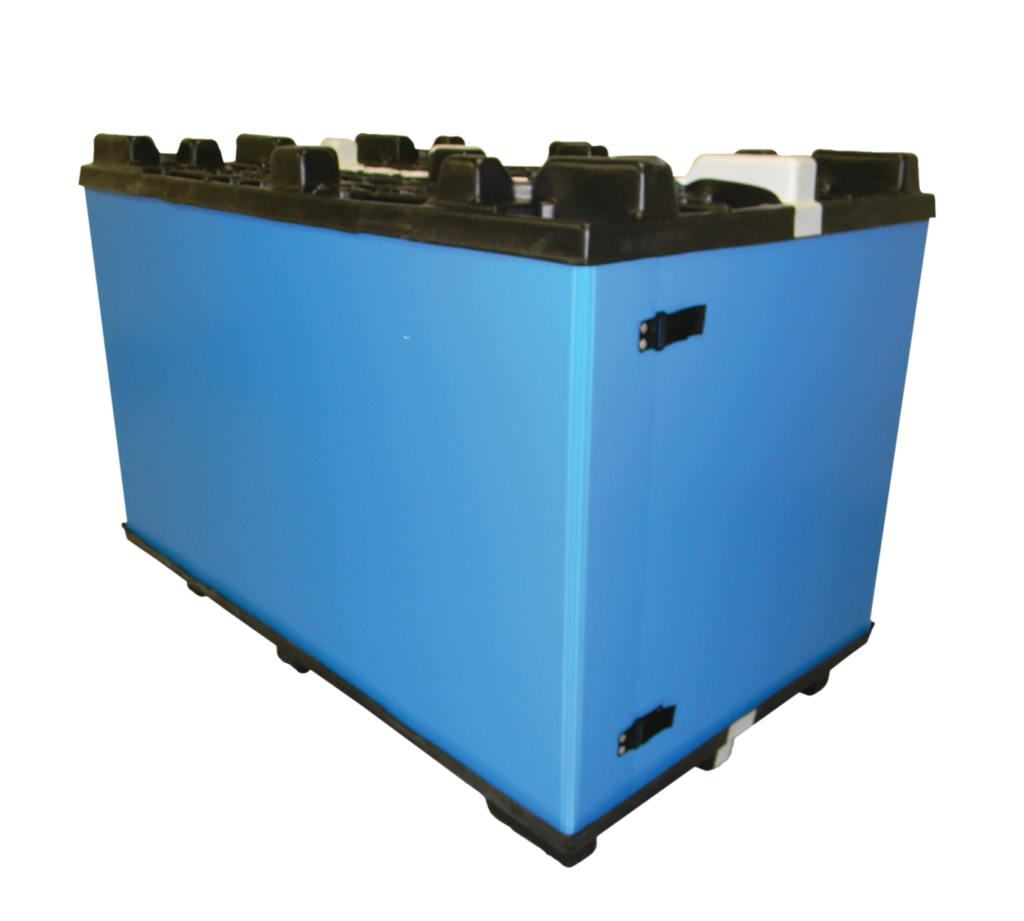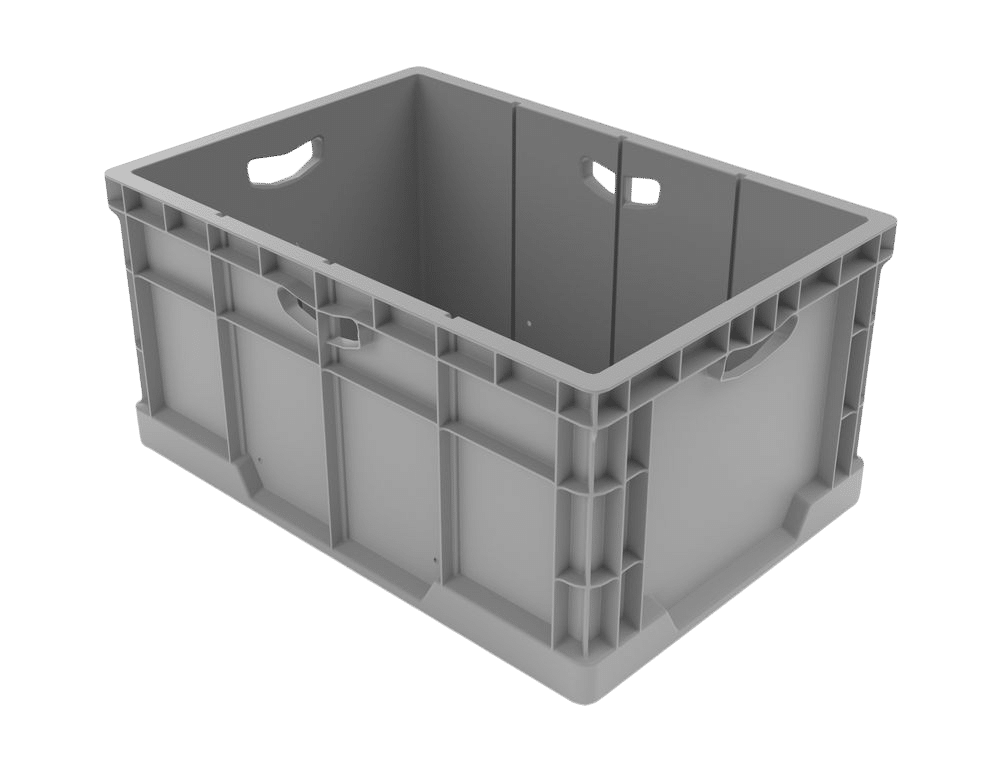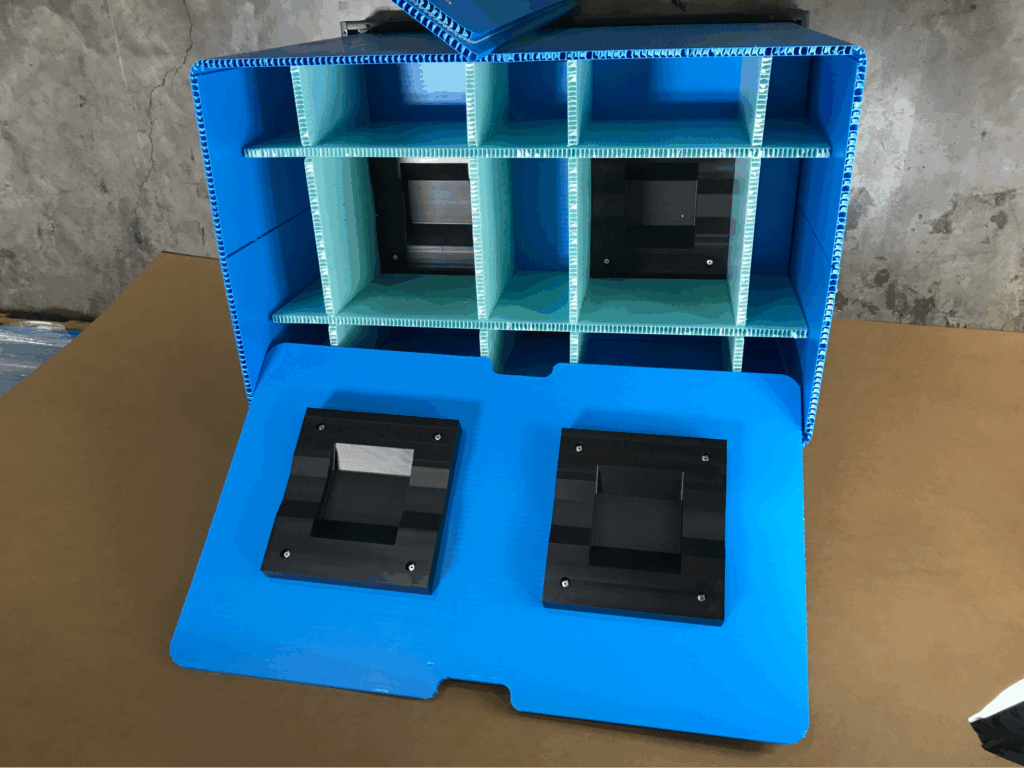Tertiary packaging plays a pivotal role in logistics by grouping multiple products into organized loads for efficient handling, transport, and storage. It is a cornerstone of industrial packaging and a key aspect of many material handling solutions, ensuring goods reach their destination intact while streamlining warehouse operations. By providing secure packaging solutions that reduce damage risks, tertiary packaging supports regulatory compliance and contributes to sustainability initiatives in modern supply chains.
This article examines how tertiary packaging advances supply chain performance, highlighting its function, key components, industry applications, emerging innovations, and future trends that help organizations enhance operations and reduce costs.
The Role of Tertiary Packaging in the Packaging Hierarchy
Packaging is essential in ensuring products arrive in optimal condition. While primary packaging contains the product and secondary packaging groups items for retail or storage, tertiary packaging consolidates these secondary packages into one manageable load. This final layer simplifies handling, reduces damage, and improves inventory control during large-scale shipments or smaller-scale packaging for transportation. As logistics demands evolve, tertiary packaging is increasingly designed for durability, cost efficiency, and compatibility with automated systems, making it an essential form of packaging for storage as well.
The packaging hierarchy is structured as follows:
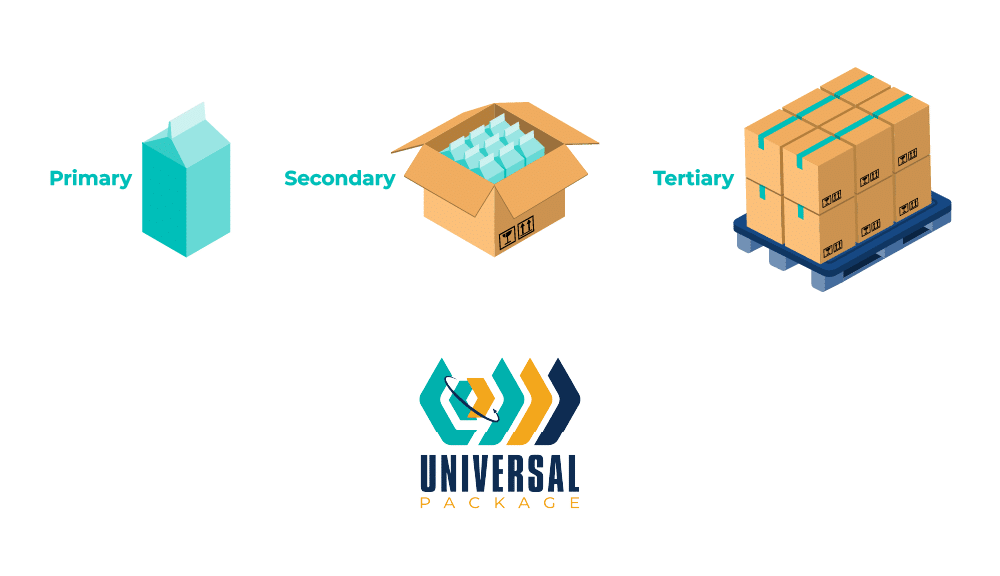
- Primary Packaging: Directly surrounds the product (e.g., bottles, wrappers) and focuses on containment and presentation.
- Secondary Packaging: Groups primary packages together (e.g., boxes) for storage or retail display.
- Tertiary Packaging: Consolidates secondary packages into organized loads (e.g., pallets, bulk containers) for efficient transportation and storage.
Tertiary packaging is the external layer used for grouping and securing goods prior to transport. It transforms numerous smaller packages into a single unit that is easier to move and track. Converting scattered packages into stable unit loads minimizes handling errors, reduces damage, and improves supply chain predictability. Whether facilitating packaging for transportation or for storage in large distribution centers, it remains a crucial element of modern logistics operations.
Core Purpose of Tertiary Packaging
Tertiary packaging performs several key functions:
Protection Throughout the Supply Chain
It guards products against physical impacts, vibrations, and environmental conditions. Robust tertiary packaging minimizes product loss and damage during transit, ultimately reducing returns and replacement costs while offering secure packaging solutions for a variety of industries.
Enhanced Material Handling Efficiency
By consolidating products into single units, tertiary packaging streamlines loading, unloading, and storage processes. Uniform loads are easier to manage with standard handling equipment, cutting labor time and reducing error risks.
Consolidation and Unitization
This packaging creates stable unit loads that can be moved as one, optimizing warehouse space and transportation. It fosters consistency throughout the supply chain and simplifies inventory tracking.
Streamlining Logistics Processes
Standardized packaging dimensions lead to smoother operations with minimal disruptions. This consistency helps in planning shipments, reducing downtime, and maintaining overall supply chain efficiency.
Key Components and Materials
Effective tertiary packaging relies on the intelligent selection and combination of materials and components:
Pallets and Palletized Systems
Pallets made from wood, plastic, or metal serve as the foundation for stacking goods. They provide a uniform base that can be easily moved using forklifts or pallet jacks. Securing the load on a pallet with stretch wrap or straps prevents movement and potential damage.
Wrapping and Securing Materials
Films hold items together by tightly binding them to pallets or within crates. This prevents shifting during transit, thus maintaining load stability. Proper wrapping techniques can significantly reduce breakage rates.
Bulk Containers and Crates
For large or irregular items, bulk containers (or crates) offer additional protection. Constructed from durable materials such as plastic, metal, or treated wood, these containers can be a reusable packaging solution over multiple shipments.
Dunnage and Protective Padding
Materials such as foam inserts, corrugated sheets, or molded dividers fill empty spaces within containers. This padding absorbs shocks during handling and transport, preventing internal movement that could damage delicate items. Proper dunnage (including custom dunnage configurations) plays a critical role in safeguarding cargo.
Material Options
- Corrugated Fiberboard: Often employed as protective liners, it offers a lightweight yet sturdy solution that is recyclable.
- Corrugated Plastic Containers: Durable, lightweight, and reusable for extended shipping cycles.
- Foam Packaging Assemblies: Engineered to protect fragile components and sensitive products from vibration and impact.
Tertiary Packaging in the Supply Chain
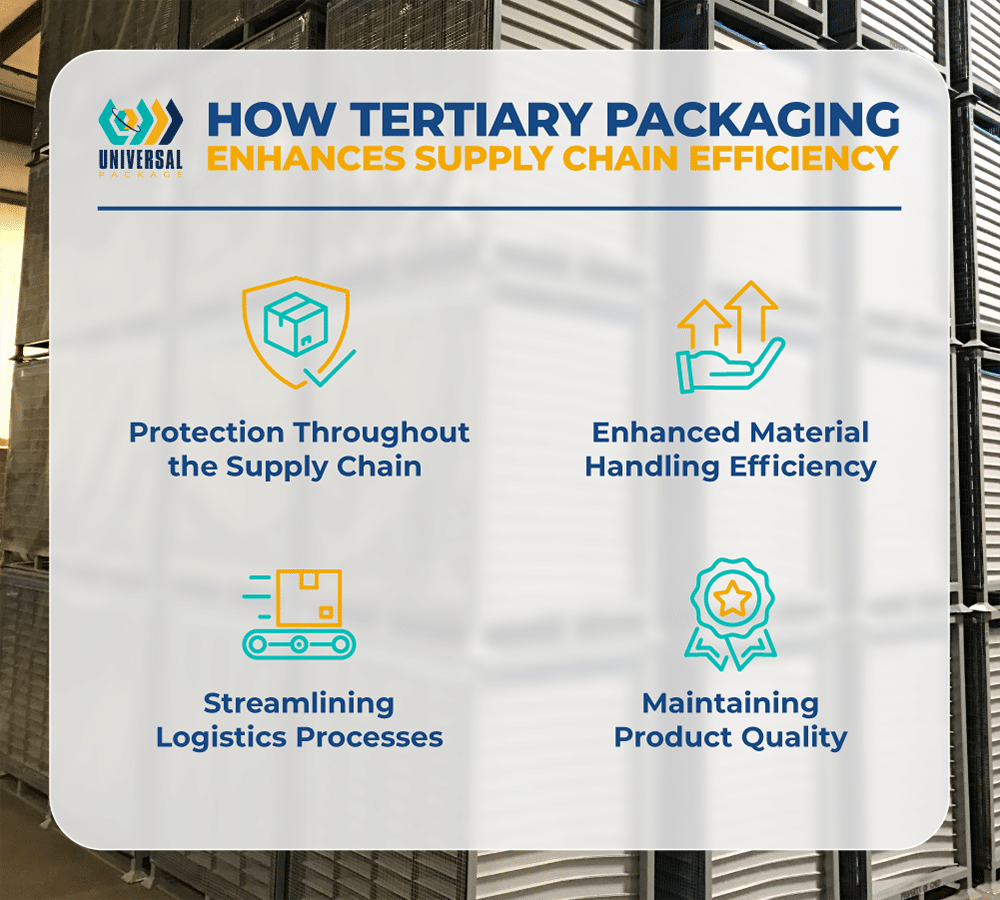
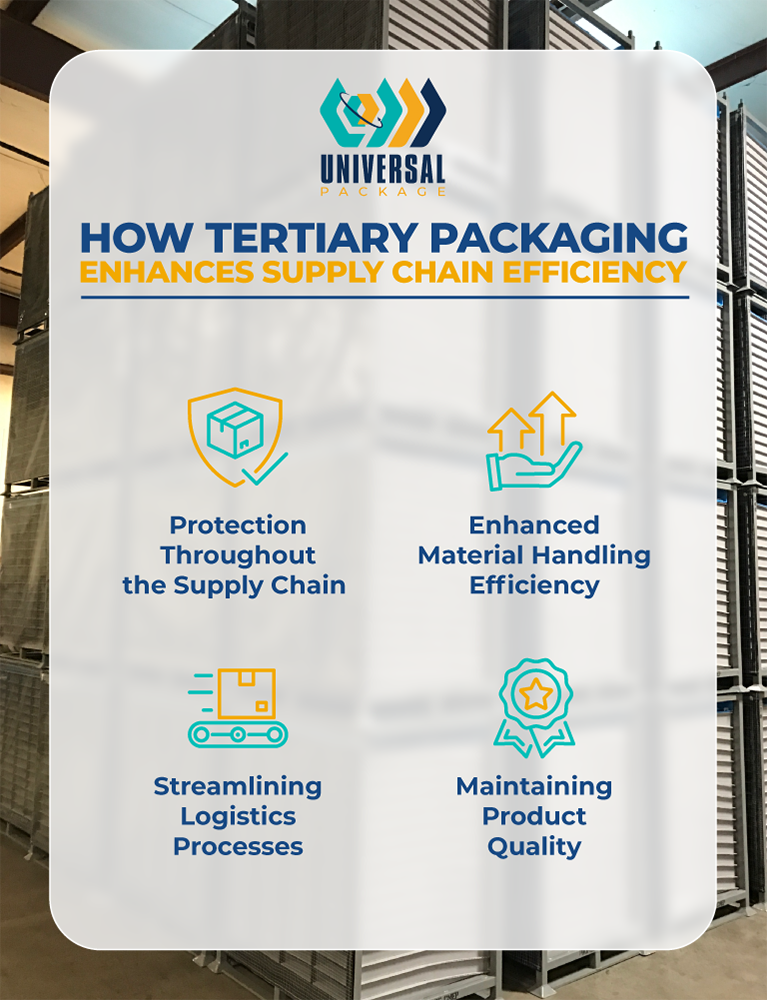
Tertiary packaging is fundamental to maintaining smooth and efficient supply chains. Its benefits are felt at every stage of the logistics process:
Safeguarding Products in Transit
Tertiary packaging protects goods from impacts, moisture, and temperature fluctuations. Whether through reinforced bulk containers or securely wrapped pallet loads, this packaging ensures that items remain undamaged under harsh handling conditions.
Streamlining Material Handling
Standardized tertiary packaging configurations facilitate the efficient use of automated equipment, ensuring that warehouses and distribution centers can process shipments faster and with fewer manual errors.
Ensuring Regulatory Compliance
For international shipments, adherence to guidelines—such as proper wood treatment and labeling—is essential. Packaging systems that emphasize compliance help avoid delays at customs and potential fines.
Maintaining Product Quality
For sensitive products like pharmaceuticals, electronics, or perishables, tertiary packaging offers specialized solutions that preserve product integrity and extend shelf life.
Tertiary packaging is the backbone of material handling solutions within industrial logistics. It stabilizes unit loads, optimizes handling processes, and supports automated warehouse systems. Research and industry insights indicate that well-designed packaging systems can help secure shipments and reduce disruptions during transit. By providing consistent protection and compliance with international standards, tertiary packaging ensures that shipments remain intact and on schedule.
Innovations and Trends
Tertiary packaging is rapidly evolving as businesses seek improvements in efficiency, sustainability, and technological integration. Key trends include:
Sustainability Initiatives
Many companies are embracing sustainability initiatives and sustainable packaging trends by shifting toward reusable or recyclable materials and biodegradable stretch films. These measures reduce waste and lower environmental impact while also cutting fuel consumption due to lighter shipment weights.
Integration of Smart Technology
Smart packaging solutions now include sensors and RFID tags to provide real-time tracking and monitoring of shipments. This innovation delivers valuable data on temperature, humidity, and movement for enhanced control over logistics operations.
Automation Compatibility
Packaging design is evolving to align with automated systems. Standardized, modular designs facilitate integration with robotic palletizers, automated guided vehicles, and conveyor systems, reducing labor costs and accelerating processing times.
Adapting to E-commerce Demands
The rapid rise in online shopping has dramatically increased the need for efficient, flexible packaging solutions. As orders become smaller and more frequent, tertiary packaging systems are being redesigned to balance protection with speed and scalability, often incorporating features that simplify returns and adaptable load configurations.
Custom and Modular Packaging Systems
The move toward custom and modular packaging systems allows businesses to quickly adapt to varying shipment sizes and product types. These stackable, collapsible, and configurable systems improve space utilization and provide flexibility during peak periods.
As industries evolve, tertiary packaging must adapt to new technological and logistical trends. The following insights highlight how forward-looking businesses can keep pace. Automation, IoT tracking, and data analytics now play vital roles in tertiary packaging. Many companies are integrating sensors within packaging materials to monitor conditions in real time, ensuring better inventory control and secure shipments. Such data-driven insights are key to refining workflows and addressing cost analysis systematically.
Cost and Efficiency Considerations
Balancing protection with cost efficiency is critical in tertiary packaging. Several factors contribute to achieving a cost-effective packaging strategy:
Protection vs. Overpackaging
Investing in high-quality packaging minimizes damage and product returns, yet overpackaging drives up costs and waste. Striking the right balance is essential to protect goods without incurring excessive material and transport expenses.
Reducing Operational Costs
Efficient tertiary packaging optimizes both warehouse space and transit capacity through standardized load dimensions. This streamlined approach reduces handling times and loading complexities, ultimately lowering transportation costs.
Benefits of Reusable Systems
Although reusable options like plastic or metal pallets may have higher initial costs, their durability offers long-term savings through repeated usage and less waste. These types of reusable packaging approaches can prove especially valuable for businesses managing global supply chains.
Avoiding Non-Compliance Costs
Packaging designed to meet established regulations helps avoid fines and customs delays, ensuring a smoother overall logistics process.
Data-Driven Optimization
By analyzing performance data—such as damage rates and processing times—businesses can directly pinpoint inefficiencies and continuously refine their packaging strategies for improved ROI.
Forward-thinking organizations can harness these advantages by integrating advanced materials, automation, and comprehensive staff training. When combined with thorough cost-benefit analyses and clear compliance objectives, tertiary packaging becomes a true driver of profitability and resilience in modern supply chain networks.
Industry-Specific Applications and Use Cases
Effective tertiary packaging is essential in a variety of industries, thanks to its ability to protect and streamline logistics operations:
Automotive Industry
Automotive manufacturers rely on durable industrial packaging—such as steel racks, reinforced crates, and properly secured pallets—to transport large, high-value components. Customized inserts and foam packaging assemblies guard sensitive parts against vibration and shock.
Pharmaceuticals and Medical Equipment
For pharmaceuticals, maintaining sterility and consistent temperatures is critical. Tertiary packaging featuring tamper-evident seals and insulated materials ensures that sensitive products remain safe and secure throughout long, regulated shipments.
Electronics and Appliances
Fragile electronics benefit from protective measures like custom dunnage and corrugated plastic containers. These solutions minimize impacts and vibrations, supporting product quality and customer satisfaction.
Food and Beverage
In the food sector, preventing spoilage is essential. Packaging solutions like shrink-wrapped pallets and insulated carriers maintain product freshness from warehouse to consumer.
Trade Shows and Events
Companies that transport display materials and exhibition booths rely on quick-assembly packaging systems that are both protective and efficient. Lightweight, collapsible crates reduce setup times and handling costs while protecting valuable displays.
Evaluating and Improving Tertiary Packaging Strategies
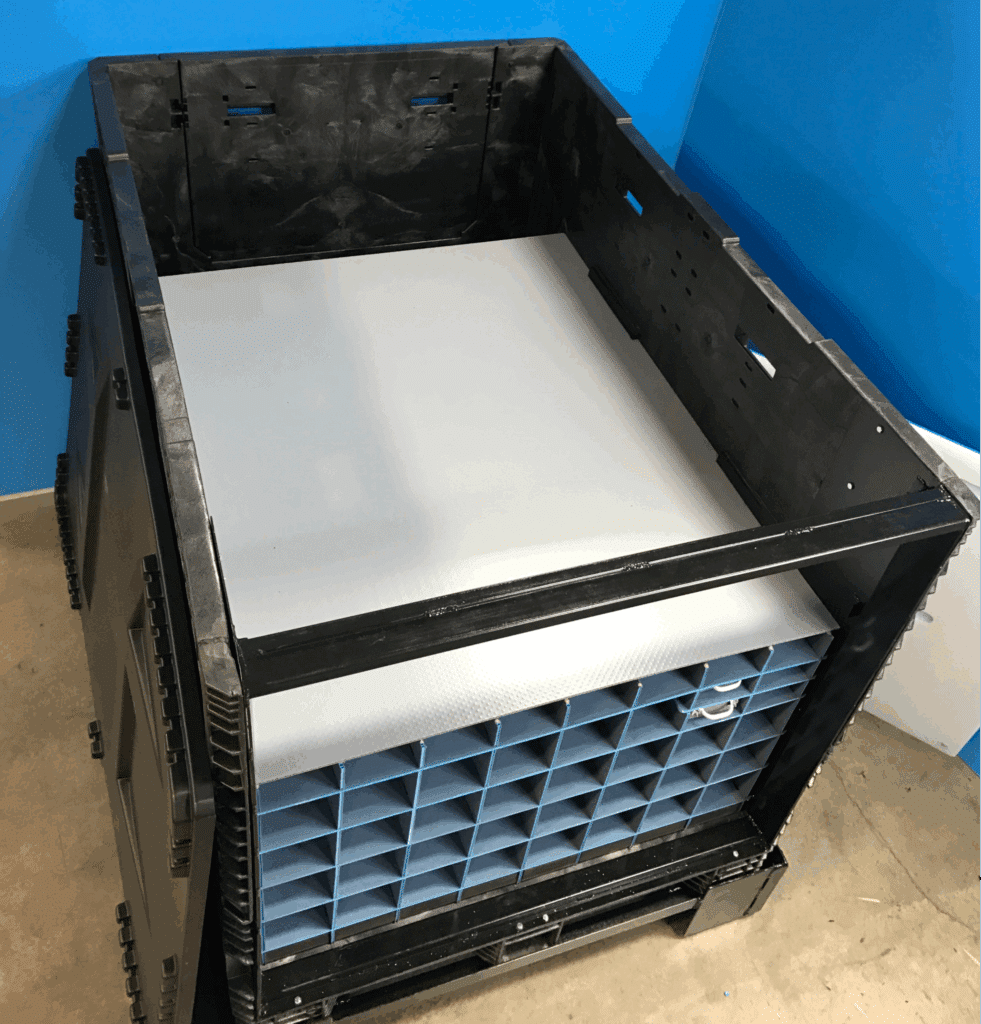
Regular evaluation and improvement of packaging systems can drive significant gains in supply chain performance. By focusing on key areas such as design, performance metrics, and collaboration with partners, companies can ensure that their tertiary packaging remains both effective and adaptable:
- Assess Current Performance: Evaluate metrics like shipment damage rates, handling efficiency, and cost data to identify areas for improvement. Honest feedback from logistics teams helps expose hidden costs and challenges.
- Collaborate with Supply Chain Partners: Engage with suppliers, freight carriers, and warehouse teams to gain insights into packaging effectiveness. Such collaboration can reveal inefficiencies and highlight opportunities for standardization or new materials.
- Experiment with Innovative Materials: Test advanced materials, improved stretch films, and collapsible containers that can handle variable load sizes. Investing in research and development often yields long-term returns through reduced damage and faster handling times.
- Standardize Practices: Implement consistent packaging standards throughout the supply chain. This reduces variability, facilitates automation, and simplifies worker training, ultimately improving productivity.
- Leverage Employee Training: Providing ongoing training on correct packaging methods not only reduces errors during handling but also encourages staff to spot inefficiencies that can be resolved.
- Monitor and Optimize with Data: Continuous tracking of key performance indicators using data analytics allows for timely adjustments and ongoing refinement of packaging processes. Small improvements can accumulate into substantial savings and more dependable operations.
Moreover, evaluating industry-specific needs—like foam packaging assemblies for delicate electronics—can further boost effectiveness. As businesses scale or enter new markets, a dynamic packaging strategy helps maintain consistency, prevent cargo damage, and keep pace with evolving customer demands.
The Vital Role of Tertiary Packaging in Modern Logistics
Tertiary packaging is a cornerstone of efficient logistics, ensuring that products are safeguarded, handling is streamlined, and costs are managed effectively. By consolidating items into stable loads, it enhances supply chain efficiency, preserves product integrity, and supports modern trends like smart technology and sustainability.
For businesses striving to reduce damage rates and maximize cost-effectiveness, reevaluating the design and materials used in tertiary packaging is paramount. To discover how custom packaging solutions from Universal Package’s solutions—including corrugated plastic containers, reusable packaging, and other material handling solutions—can optimize your operations, explore the possibilities across industries from automotive to electronics. Whether you need custom dunnage, foam packaging assemblies, or innovative strategies for large-scale shipments, Universal Package stands ready to help you enhance overall logistics performance.


